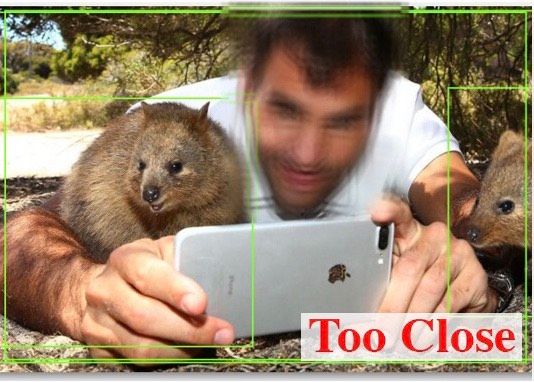WildPic
The Problem
Wildlife tourists often seek inappropriate proximity to wildlife. In addition to being a safety hazard, this behavior poses a significant risk of disease transmission from humans to wildlife, and vice versa -60% of emerging infectious diseases tend to be zoonotic. Other negative impacts of proximity to wildlife include decreasing feeding, breeding and birth rates. The World Animal Protection reported a 292% increase in "wild animal selfies" posted on Instagram between 2014 and 2017. That said, wildlife tourists are not the only representatives of inappropriate proximity to wildlife - field scientists do it too. Although the latter may need to have physical proximity with wildlife to accomplish their work, they often engage in recreational activities with animals, including restraining them for selfies. As such, the behaviors we want to focus on are the taking and sharing of animal selfies and wildlife pictures, and the resulting close proximity with animals. Our desired behavior is to maintain a safe and respectful distance (<7m), and take all necessary precautions to prevent infecting wildlife and impacting their natural behavior. This is a significant problem to solve because if we can shift behavior among tourists and scientists, we prevent the risks to already vulnerable species, reduce the probability of outbreaks among animal and human populations, and promote positive behaviors among this group of ‘alpha’ animal lovers that other groups might eventually emulate.
Our Proposal
A mobile camera application for iPhones and Android phones that uses a computer vision algorithm to determine - as a photo is taken - the distance between any humans and wildlife in the frame. A live filter would be applied to the camera viewfinder to encourage the correct proximity to the wildlife. When humans are detected at an appropriate distance a reward filter (such as a cute illustration of the wildlife being photographed) could be applied, and when humans are detected too close to wildlife a deterrent filter (such as a disgusting but still cute illustration of a virus) could be used.
We Assume that...
Technological assumptions: 1. The computer vision models available for this project are accurate enough to detect inappropriate proximity between humans and wildlife.
2. The computer vision models available for this project are fast enough to allow for unimpeded use of the camera, people will not use a “lagging” or annoying camera application.
4. The reward of using this camera application and remaining at appropriate proximity to wildlife is greater than the reward of getting as close as possible to the wildlife for a photo.
5. The camera will initiate lasting behavioral change that will spread via social media.
Human assumptions: 3. People will be motivated to download the camera application and use it instead of their regular camera application to take photos during a wildlife experience.
Constraints to Overcome
To date, two major dynamics have perpetuated this problem. First, tourists don’t know they can transmit pathogens to wildlife. Instead, they get close to animals to take photos with them to share on social media, and get positive affirmation e.g. likes. Others are then inspired to seek similar close encounters with wildlife, and the cycle continues. Second, national parks and tour operators are apprehensive about enforcing disease prevention practices because they’re afraid they will put off tourists and suffer a loss of reputation and income. Tour guides face mixed incentives, and constantly make trade-offs between tourist and animal safety providing a memorable experience. We plan to reverse this vicious cycle by shifting the knowledge burden and decision-making from tour operators/guides, to tourists and ambassadors such as scientists. The tour guides and ambassador scientists now just need to encourage the use the camera app, and make tourists responsible for their own decisions.
Current Work
Preparation (1st - 4th month): 1. Partner with experts to develop the proximity evaluation algorithm for the camera app 2. Document existing data required in the app (e.g. species of animal, appropriate distance, potential diseases) 3. Contact field operators and ambassadors (e.g. renowned field scientists) to gauge their motivation to use and promote the proposed app 4. Design the application and build mobile app mockups 5. Invite field experts or scientists to try the mockups Launching the application (5th - 6th month) 1. Launch the app to AppleStore and GooglePlay 2. Promote the app to field scientists and the public health sector through direct connections (e.g. universities, professional conferences) 3. Partner with 2-3 tour operators interested in promoting the app to their visitors 4. Prepare materials for tour operators to introduce the app 5. Promote the app through social media, targeting wildlife tourists 6. Prepare articles and press release for media publication
Current Needs
1. Additional mobile application developer (iPhone) for developing the mobile camera application (we have Android development knowledge on our team) 2. Graphic artists for producing visual assets for the reward and deterrent filters for the mobile camera application 3. Funding to develop the computer vision model on Google’s AutoML Vision Edge
